
SEASON
13, 15, & 16, 2023
Mahler’s Titan 2022/2023
April
Completely engaged. That’s how Joe Coyle feels about his life at Judson Manor.




An award-winning journalist who has lived in Paris, Santa Fe, and New York City, he arrived in July 2020 via the suggestion of a fellow resident. He’s been delighted ever since.

“As a writer, I enjoy spending time alone, and these surroundings are perfect: my apartment is quiet, and the views overlooking the Cleveland Museum of Art are lovely. But by far the best part of Judson is the people. Everyone is so knowledgeable about art and culture. I wanted to have stimulating company to spend my time with, and I’ve found that here. These are wonderful, interesting people,” says Joe.
Read the full story at judsonsmartliving.org/blog
Judson Park Cleveland Heights | Judson Manor University Circle | South Franklin Circle Chagrin Falls Learn more about how Judson can bring your retirement years to life! judsonsmartliving.org | 216.446.1579
“Expanding my curiosity about life is what it’s all about.”
Joe Coyle
2022/2023 SEASON
Mahler’s Titan
Thursday, April 13, 2023, at 7:30 p.m.
Saturday, April 15, 2023, at 8:00 p.m.
Sunday, April 16, 2023, at 3:00 p.m.
Michael Tilson Thomas, conductor
Claude Debussy (1862–1918)
Jeux; poème dansé 15 minutes
Fantaisie for Piano and Orchestra 25 minutes
I. Andante ma non troppo — Allegro giusto
II. Lento e molto espressivo
III. Allegro molto
Leif Ove Andsnes, piano
INTERMISSION 20 minutes
Gustav Mahler (1860–1911)
Symphony No. 1 in D major, “Titan” 55 minutes
I. Langsam, schleppend: wie ein Naturlaut (Slow, dragging: as if spoken by nature)
II. Kräftig bewegt, doch nicht zu schnell (With powerful movement, but not too fast)
III. Feierlich und gemessen, ohne zu schleppen — Sehr einfach und schlicht wie eine Volksweise (Solemn and measured, without dragging — Very simple, like a folk tune) —
IV. Stürmisch bewegt — Energisch (Agitated in storm — Energetic)
Total approximate running time: 1 hour 55 minutes
Thank you for silencing your electronic devices.
2022/2023 Season Sponsor
This weekend’s concerts are dedicated to Mr. William P. Blair III in honor of his generous support and advocacy for arts in Northeast Ohio. A memorial in his memory will take place on April 25 at 6:00 p.m. at Severance Music Center and is open to the public.
clevelandorchestra.com
THE CLEVELAND ORCHESTRA
JACK, JOSEPH AND MORTON MANDEL CONCERT HALL AT SEVERANCE MUSIC CENTER COVER: PHOTO BY ROGER MASTROIANNI
– Vincent Briley, Cleveland Orchestra supporter

Season’s end marks your last chance to support the magical, musical moments you love. Community support makes every moment on stage possible.
Play your part — make your donation today!
clevelandorchestra.com/give
Above: Principal Cellist Mark Kosower takes a bow following his performance in Bloch’s Schelomo

“This is your history. This is your Orchestra. This belongs to you.”
THIS WEEKEND , guest conductor Michael Tilson Thomas returns to Severance with works by Claude Debussy and Gustav Mahler, two composers who — though born only two years apart — occupied vastly different soundworlds.

Earlier this year, The New Yorker’s Alex Ross wrote, “no one alive conducts [Debussy] better” than Tilson Thomas, and the first half of the program juxtaposes two of the French composer’s lesserknown works from opposite ends of his career. Jeux (1912–13) brought together the most significant dance company of the first part of the 20th century, the Ballets Russes, with the most important French composer of the era, Debussy. Though Nijinsky’s choreography to this poème dansé about an amorous tennis match has been lost, the score has been championed for its inventive structure and orchestral color.
Debussy’s Fantaisie for piano and orchestra was written more than two decades before Jeux and just after his first encounter with a Javanese gamelan orchestra at the Paris Exposition Universelle of 1889. Norwegian pianist Leif Ove Andsnes joins for this work that points toward the subtly revolutionary music that would quickly flow out of Debussy.
Around the same time that Debussy discovered gamelan music, Gustav Mahler was putting the final touches on his First Symphony. Mahler’s first entry into the genre for which he would become known awakens with the wonders of nature, simmers with the joyful indiscretions of youth, and delves into the darker side of humanity before culminating in an epic battle between the protagonist and his fate. All are themes that cycle through his subsequent symphonies, at once broadly universal and intimately autobiographical.
“There would have been a kind of soundscape which [Mahler] was hearing,” Tilson Thomas explained in the illuminating podcast, Embrace Everything — The World of Gustav Mahler. “It was the setting down the kind of recording of that soundscape — and more importantly his emotional reactions to that soundscape — that really became the purpose of what he was writing.” — Amanda
Angel
THE CLEVELAND ORCHESTRA | 3 clevelandorchestra.com
INTRODUCTION
PHOTO BY KRISTEN LOKEN
Jeux; poème dansé
By Claude Debussy
BORN : August 22, 1862, in St. Germain-en-Laye, France
DIED: March 25, 1918, in Paris
Ω COMPOSED : 1912-13
Ω WORLD PREMIERE: May 15, 1913, in a staged production by the Ballets Russes at Paris’s Théâtre des Champs-Élysées with Pierre Monteux conducting
Ω CLEVELAND ORCHESTRA PREMIERE: March 11, 1965, conducted by Pierre Boulez in his Cleveland Orchestra debut
Ω ORCHESTRATION: 2 flutes, 2 piccolos, 3 oboes, english horn, 3 clarinets, bass clarinet, 3 bassoons, contrabassoon, 4 horns, 4 trumpets, 3 trombones, tuba, timpani, percussion (xylophone, triangle, tambourine, cymbals), 2 harps, celeste, and strings
Ω DURATION: about 15 minutes
WHEN HE LAUNCHED his Paris-based ballet company Ballets Russes in 1909, impresario Sergei Diaghilev set out to enlist as many of the world’s leading composers as possible. While Igor Stravinsky soon became a favorite collaborator, over the course of a remarkable couple of decades, Diaghilev commissioned works from Maurice Ravel (Daphnis et Chloé), Richard Strauss (Josephlegende), Manuel de Falla (The Three-Cornered Hat), and Sergei Prokofiev (The Buffoon, The Step of Steel, and The Prodigal Son). He wasn’t about to overlook the composer who at the time was regarded as the greatest of French musicians, Claude Debussy.
Debussy’s contact with Diaghilev began in 1912 when the company presented his Prelude to the Afternoon of a Faun with Vaslav Nijinsky in the title role. The music, written 20 years earlier, was by then well-established in concert repertoire. The premiere of the ballet, however, was widely criticized for Nijinsky’s work as a choreographer — this was the great dancer’s debut in that capacity. As shocking as some of Nijinsky’s gestures were to a large part of the audience, the ballet was still quite successful as theater (some called it a succès de scandale), and Diaghilev was keenly interested in commissioning an original score from Debussy for the company’s next season.
4 | 2022/2023 SEASON
THE MUSIC
The scenario that Nijinsky proposed to Debussy was “a plastic vindication of humanity in 1913,” by which he meant a bold assertion of modernity. This modernity came from using a modern game —tennis, whose governing body, the International Lawn Tennis Association, was founded that same year — to inspire the action of the ballet. Far removed from the mythology of Ravel’s Daphnis et Chloé or the pagan ritual of Stravinsky’s Rite of Spring, tennis could easily seem a better representation of humanity in 1913. Yet, while the subject matter seemed contemporary,
Edward Lockspeiser writes in his book on Debussy: “The story of the three tennis-players who, having lost their ball, turn their search into a flirtation scene, is in itself not more than attractively naïve.”
Nijinsky provided this synopsis: “The scene is a garden at dusk; a tennis ball has been lost; a young man and two girls are searching for it. The artificial light of the large electric lamps shedding fantastic rays about them suggests the idea of childish games — they play hide and seek, they try to catch one another, they quarrel, they sulk without cause. The night is warm, the sky is bathed in a pale light; they embrace. But the spell is broken by another tennis ball thrown in mischievously by an unknown hand. Surprised and alarmed, the young man and the girls disappear into the nocturnal depths of the garden.”
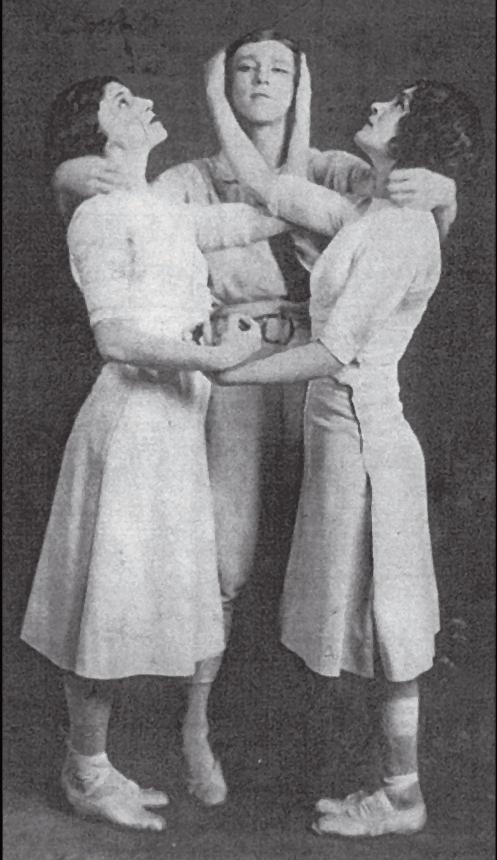
Of course, this synopsis is not rich in dramatic twists. But the agility of the tennis game and the charming antics of the three young people captured Debussy’s musical imagination. And it seemed to be exactly the kind of story, not too concrete in details yet filled with poetic images, that he could work with best.
Music critic Émile Vuillermoz later described how Debussy’s music is able to express the tennis game: “This supple music is extraordinarily nimble, always ready for sudden movements. It is constantly on the alert like the tennis players it describes. Every few bars its movement and color change. It quickly
THE CLEVELAND ORCHESTRA | 5 clevelandorchestra.com
l-r: Tamara Karsavina, Vaslav Nijinsky, and Ludmilla Schollar form the iconic “fountain” pose from Jeux (1913).
PHOTO BY CHARLES GERSCHEL
abandons a design, a timbre, an impulse, and rushes off in another direction. Presently, the melody is returned with a skillful backhand stroke; the theme, dexterously taken, is sent to and fro in volleys or half-volleys, now stopped short in its course, now taken on the rebound like a cut ball.”
Part of Debussy’s success in this score is what he called music “lit from behind,” which was his way of describing transparence in the melodic writing so that the contrast between theme and accompaniment almost disappears, with background and foreground playing equally important and balanced roles.
Interestingly, Jeux —Debussy’s last completed orchestral score — remained relatively unknown for decades after it was written. It didn’t start to attract widespread attention until the 1950s, when its innovative musical ideas came to be better understood. It seems that the portrait of humanity in 1913 may indeed be found in Jeux, but in Debussy’s music rather than in Nijinsky’s banal story. Jeux survives today almost exclusively as a concert piece, and as such, it is both one of Debussy’s most exciting works and one of the great scores written for Sergei Diaghilev and the Ballets Russes.
 — Peter Laki
— Peter Laki
6 | 2022/2023 SEASON THE MUSIC
Peter Laki is a musicologist and frequent lecturer on classical music, and a visiting associate professor at Bard College.
The nuanced love triangle of Jeux was quickly overshadowed by Nijinsky’s next ballet, presented two weeks later: the riot-inducing Rite of Spring
PHOTO BY CHARLES GERSCHEL
Fantaisie for Piano and Orchestra
By Claude Debussy
Ω COMPOSED : 1889–90
Ω WORLD PREMIERE: November 20, 1919, in London with pianist Alfred Cortot and the Royal Philharmonic Orchestra, and on the same day in Lyon, France, with soloist Marguerite Long
Ω CLEVELAND ORCHESTRA PREMIERE: Debussy’s Fantaisie has only been presented once prior to this season, on October 23 and 25, 1930, conducted by Nikolai Sokoloff with soloist José Iturbi.
Ω ORCHESTRATION: 3 flutes, 2 oboes, english horn, 2 clarinets, bass clarinet, 3 bassoons, 4 horns, 3 trumpets, 3 trombones, timpani, cymbals, 2 harps, and strings, plus solo piano
Ω DURATION: about 25 minutes
THE FANTAISIE FOR piano and orchestra is an early work, that is to say it precedes the revelation of Debussy’s genius that came with the three works Prelude to the Afternoon of a Faun, the String Quartet, and the opera Pelléas et Mélisande, all composed in the early 1890s. Having won the coveted Prix de Rome in 1884, he returned from Rome two years later with the expectation, at least in his parents’ minds, that success would follow. But his temperament and independent spirit made him unwilling to pursue established professional paths, and throughout his life he found it difficult to commit himself to works that failed to satisfy his sometimes severe self-criticism.
Friendship with the pianist René
Chansarel in 1889 and his need to write a big orchestral work led him to the plan for a piano concerto, although it was never called that, instead being left unclassified as a Fantaisie. The plan hardly chimed with his passion for Wagner’s Parsifal, triggered by a second visit to Bayreuth that year, but he went firmly ahead so that it was ready for performance in April 1890. The Société Nationale de Musique, which had been promoting young French composers for 20 years, included it in a long program presented that month. It was so long that Vincent d’Indy, who was to conduct Debussy’s work, decided at the last moment to perform only the first movement. Debussy, outraged, responded by
THE CLEVELAND ORCHESTRA | 7 clevelandorchestra.com
removing all the parts from the players’ stands, so that the Fantaisie was not performed at all.
Many years later a friend recalled the incident. “Debussy looked very handsome, dressed all in black, with a soft billowing shirt and cravate. Our Prince of Darkness. A small group of friends were very happy, but Debussy was silent and absorbed. Afterwards at the brasserie next to the Molière memorial fountain Debussy told me: ‘I’m going to withdraw my Fantaisie.’ ‘Why? Didn’t you like
the performance?’ ‘Yes, yes, but I’m not satisfied with the finale.’ There was no point in arguing. With his own music at that time, he was unmovable.”
There was talk of a performance in 1892, again in 1895, and again in 1903, but none of these took place. Debussy insisted that he intended to revise it, but the changes he wanted to make were not brought to light until 1968. As he explained to fellow composer Edgard Varèse in 1909: “I have changed my ideas about how to write for the piano with an orchestra. The orchestral part ought to

8 | 2022/2023 SEASON THE MUSIC
The Javanese Village at the 1889 Exposition Universelle in Paris, where Debussy first encountered the gamelan music that would influence his mature style.
Claude Debussy at the piano, entertaining guests at Ernest Chausson’s Paris salon (1893).
PHOTO COURTESY OF PHOTO 12/ALAMY STOCK PHOTO
be written differently, otherwise you just hear an idiotic battle between two individuals!” A little later he wrote: “I will definitely not abandon this child.”
The Fantaisie was first heard in 1919, the year after Debussy’s death, when it received performances on the same day in both London and Lyon.
Debussy divided the work into two movements, but the listener may prefer to think of it as in three movements, like a traditional concerto, with the finale running on from the slow movement. The piano part is highly elaborate and active, and the familiar marks of Debussy’s style are evident throughout: the sensuous harmony, the impulsive shifting of keys, the repetition of short phrases. The first movement has a brief, suggestive introduction and a main Allegro in a strong, positive spirit.
The slow movement is full of gorgeous, languid moments, and a rhapsodic passage with much fluttering from the piano links it to the vigorous final section.
There are hints throughout of the masterworks to come, of the sinister forest in Pelléas, for example, and of the orchestral Nocturnes and La mer. Debussy had no reason to be ashamed of his Fantaisie, but for reasons he kept to himself, it joined the long list of unfinished and unperformed works that accumulated steadily throughout his life. Today, we can enjoy it fully, free of any such painful scruples.
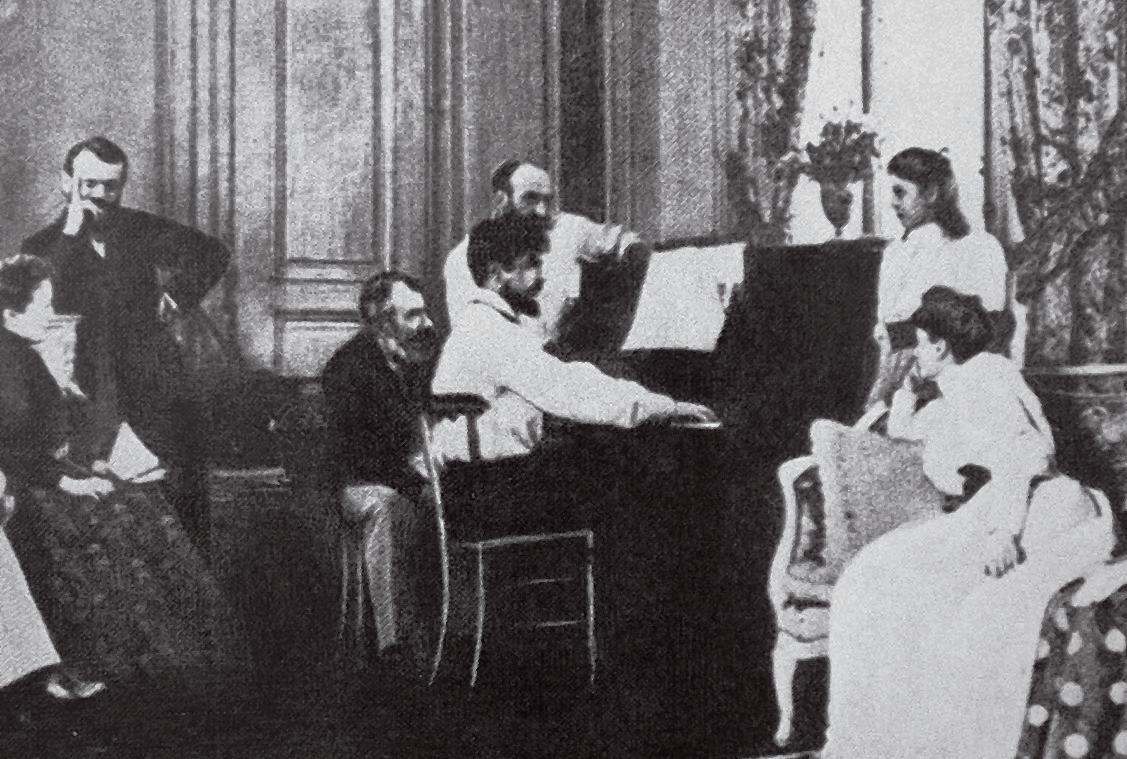 Macdonald
Macdonald
THE CLEVELAND ORCHESTRA | 9 clevelandorchestra.com
— Hugh
PHOTO
Hugh Macdonald is Avis H. Blewett Professor Emeritus of Music at Washington University in St. Louis. He has written books on Beethoven, Berlioz, Bizet, and Scriabin, as well as Music in 1853: The Biography of a Year
COURTESY OF WIKIMEDIA COMMONS
Symphony No. 1 in D major, “Titan”
By Gustav Mahler
BORN : July 7, 1860, in Kalischt, Bohemia, the present-day Czech Republic
DIED: May 18, 1911, in Vienna
Ω COMPOSED : 1884–89
Ω WORLD PREMIERE: November 20, 1889, as “A Symphonic Poem in Two Parts” in Budapest, with Mahler conducting. The four-movement Symphony in D major was first performed on March 16, 1896, in Berlin.
Ω CLEVELAND ORCHESTRA PREMIERE: January 2, 1942, with Artur Rodziński conducting
Ω ORCHESTRATION: 4 flutes (third and fourth doubling piccolo), 4 oboes (third doubling english horn), 4 clarinets (third doubling bass clarinet and E-flat clarinet, fourth doubling E-flat clarinet), 3 bassoons (third doubling contrabassoon), 7 horns, 4 trumpets, 3 trombones, tuba, 2 sets of timpani, harp, percussion (triangle, cymbals, bass drum, tam-tam), and strings
Ω DURATION: about 55 minutes
DURING HIS LIFETIME , a majority of Mahler’s fame and fortune came from his great skill as a conductor. Following a few short years of apprenticeship among the provincial opera houses of Europe, he quickly emerged as one of the foremost conductors of his time — and eventually became music director of the Vienna State Opera and conductor of the Vienna Philharmonic, and then chief conductor in New York at the Metropolitan Opera and the New York Philharmonic.
It took the world far longer to accept Mahler’s genius as a composer. Indeed, a number of his late works were not
premiered until after his death — and it was well into the second half of the 20th century before his symphonies became standard fare at concerts throughout the world.
The First Symphony is a product of Mahler’s “wandering years” as a young composer. Like the hero of his first great song cycle, Songs of a Wayfarer, he could be considered a wayfarer in the 1880s, moving from city to city and from conducting job to conducting job until, finally, in 1888, he landed his first important post as director of the Royal Opera in Budapest at the age of 28.
10 | 2022/2023 SEASON
THE MUSIC
Mahler’s outward success as a conductor, however, did not translate into understanding for his First Symphony, which was especially poorly received at its early performances. Audiences in Budapest (1889), Hamburg and Weimar (1893), and Vienna (1900) were equally bewildered by what they heard as total musical chaos and an unacceptable mixture of conflicting emotions and ideas. This might surprise us today, given the great popularity of Mahler’s music in our time, but 100 years ago, Mahler’s departures from classical form were too great — or too unexpected — for his contemporaries to grasp hold of immediately.
Other composers had written masterpieces in their 20s, but few had exercised such independence from their models as Mahler. As the composer himself once remarked, Beethoven had started out as a Mozartian composer, and Wagner as a follower of Weber and Meyerbeer; but he, Mahler, “had been condemned by a cruel fate to being himself from the start.” To Mahler — as to Beethoven before him — the symphony was a form of drama. In later years, he would speak about the universality of the symphony and the necessity for it “to embrace everything.” This heaven-storming attitude is already evident in the First Symphony. It accounts in no small part for the difficulties encountered by Mahler during the work’s genesis, both before and after the Budapest premiere in 1889.
The first performance of this work was given under the title “Symphonic
Poem in Two Parts” (with five movements grouped together into two halves). This title alluded to the existence of a literary or dramatic inspiration, but Mahler did not reveal the source. When the symphony was performed again in 1893, Mahler gave it a new title, “Titan,” after a novel by a German Romantic writer named Jean Paul (1763–1825). After 1896, however, he removed the title, eliminated one movement, and arranged the others as we know them today.
Mahler also withdrew the story-like explanations of the symphony’s program that he had written — and subsequently disavowed all such programmatic discussions of his later symphonies. Mahler was all too aware of the dangers inherent in such commentaries, for they rarely do justice to the music and can even create a false impression that they actually explain what is happening during the symphony’s music. The so-called programs he did write can perhaps best be understood as attempts on Mahler’s part to verbalize, often after the fact, the kinds of emotional sensibilities that the music evoked in his mind while composing. The real story of this symphony is how far Mahler went in expanding conventional forms to produce a complex and monumental work.
The symphony’s first movement utilizes the basic melody of one of Mahler’s early songs, from his Songs of a Wayfarer group. This song, Ging heut’ morgen über’s Feld (I Walked This Morning Through the Field), depicts a happy summer morning with flowers
THE CLEVELAND ORCHESTRA | 11 clevelandorchestra.com
blooming and birds singing. We understand that the entire movement can be seen to describe the gradual awakening of spring. We hear the musical interval of a perfect fourth (Mahler called it “a sound of nature” in the score) — and everything grows out of this one interval, like a tree from a small seed. Even the call of the cuckoo bird, evoked by the clarinet, is a perfect fourth (although real cuckoos sing an interval closer to a third).
The second movement is based on the Austrian country dance called the Ländler and is one of many Mahlerian movements inspired by this type of dance. A simple, rather unassuming tune, it is played with great rhythmic energy
and is soon taken up by the full orchestra, with a large brass section comprising seven horns and four trumpets, and with the tempo marking “Wild.”

Mahler called the third movement by several different titles, including “À la pompes funèbres” (In the Manner of a Funeral March) and “Funeral March in Callot’s Manner” (in honor of 17thcentury French engraver Jacques Callot whose satirical etchings anticipate those of Goya by a century). The immediate inspiration came from a popular woodcut by Moritz von Schwind (whom Mahler likely mistook for Callot) called The Hunter’s Funeral Procession, in which the hunter is buried by the animals of the forest. The first audiences had much trouble with this movement’s somewhat odd structure and form, but they


12 | 2022/2023 SEASON THE MUSIC
The Hunter’s Funeral Procession (1850) by Austrain artist Moritz von Schwind.
certainly recognized the popular “Frère Jacques” melody. The alienation of this familiar tune played here in the minor mode yields an eerie mixture of humor, tragedy, mystery, and irony.
This grotesque funeral march evolves into an openly parodistic section whose unabashedly schmaltzy themes, played by oboes and trumpets, are reminiscent of Eastern European Jewish klezmer folk music. The melodies of two more of Mahler’s Wayfarer songs (By the Road Stands a Linden Tree and My Sweetheart’s Two Blue Eyes) are juxtaposed against this material, creating an interesting atmosphere of contrast that is at times painfully nostalgic. A more subdued recapitulation of the “Frère Jacques” tune and the klezmer material ends this unusual movement.



The finale, which follows the funeral march without a pause, is the longest and most complex movement in the symphony. Like the last movements of many earlier symphonies, it represents a progression from tragedy to triumph, but here the contrasts among the various emotions are exceptionally polarized. The fabric of this movement includes a lyrical second theme that — as in several of Mahler’s later symphonies — seems to introduce us to a completely different world. There are also exuberant climaxes followed by relapses into despair, plus numerous recurrences of materials from the first movement. Finally, the work ends in a radiant D-major coda proclaiming a final victory.
— Peter Laki
THE CLEVELAND ORCHESTRA | 13 clevelandorchestra.com
IMAGE COURTESY OF GUSTAVMAHLER.COM









George Balanchine’s Serenade Playhouse Square’s Connor Palace | April 21-22, 2023 For tickets & additional information: clevelandballet.org | 216-320-9000 x 107 | 23020 Miles Road, Cleveland The premiere of the Cleveland Ballet Orchestra!



Let our cast of designers help you decide which style is right for your home. Undecided Where To Sit? 34300 Solon Road | Solon, OH | 440-248-2424 | 800-260-2949 One block south of Rt. 422 & SOM Center Road 9-9 M/Th | 9-5:30 Tu/W/F/Sa | www.sedlakinteriors.com Complimentary Delivery and Set-Up Within 60 Miles. CELEBRATING









™ ljicollisioncenter.com Orange Village Do YOU LOVE Horseshoe Lake? Do YOU want to HELP SAVE Horseshoe Lake? Check Out the Horseshoe Lake Restoration Plan www.SaveHorseshoeLake.com/FOHSL-Plan Customer Confidence – Priority One Lauren Angie Jill Strauss fourth generation in the industry LJI builds confidence in every customer and ensures quality repairs and superior customer service. Our commitment is to achieve and retain customer loyalty for life! 27100 Chagrin Blvd.1640 Lee Rd. NOW TWO LOCATIONS LJI builds confidence in every customer and ensures quality repairs and superior customer service. Our commitment is to achieve and retain customer loyalty for life! 27100 Chagrin Blvd. at I-271 Orange Village (216) 1640 Lee Rd. at Mayfield Cleveland Hts. 364-7100 (216) 932-7100 TWO LOCATIONS Customer Confidence – Priority One™ ljicollisioncenter.com


Adella, our streaming service and app, features on-demand portraits, music showcases, behind-thescenes footage and our flagship In Focus premium concert series, available anytime & anywhere THE CLEVELAND ORCHESTRA DIGITAL CONCERTS STREAMING NOW! Visit Adella.live to start your free trial.

Michael Tilson Thomas

MICHAEL TILSON THOMAS is music director laureate of the San Francisco Symphony, conductor laureate of the London Symphony Orchestra, and cofounder and artistic director laureate of the New World Symphony. A 12-time Grammy Award winner, he has conducted the major orchestras of the world.
Born in Los Angeles, he studied conducting and composition with Ingolf Dahl and with artists including Igor Stravinsky and Aaron Copland. In his 20s, he was assistant conductor — later principal guest conductor — of the Boston Symphony Orchestra. He also served as music director of the Buffalo Philharmonic, principal guest conductor of the Los Angeles Philharmonic, and principal conductor of the LSO.
He made his Cleveland Orchestra debut on August 2, 1974, at Blossom Music Center, followed by his Severance debut in November 1978.
In 1987, he cofounded the New World Symphony, a postgraduate orchestral academy in Miami Beach dedicated to preparing young musicians of diverse backgrounds for leadership roles in classical music. He has worked with more than 1,200 NWS Fellows, nine of whom are members of The Cleveland Orchestra.
Last fall, Mr. Tilson Thomas led side-byside performances of both orchestras during Cleveland’s Miami residency.
He became music director of the San Francisco Symphony in 1995, ushering in a period of significant growth and
heightened international recognition for the orchestra. He led SFS in championing contemporary and American composers alongside classical masters. As music director laureate, he conducts the orchestra each season.
His discography includes more than 120 recordings, and his television work includes series for the BBC and PBS, the New York Philharmonic’s Young People’s Concerts, and numerous televised performances. Michael Tilson
Thomas: Where Now Is aired on PBS’s American Masters series in fall 2020.
An active composer, major works include From the Diary of Anne Frank and Meditations on Rilke, which he conducted in Cleveland in February 2020. Yuja Wang performs his work, You Come Here Often?, on her 2023 release, The American Project.
He is an Officier de l’Ordre des Arts et des Lettres of France, member of the American Academies of Arts & Sciences and Arts & Letters, National Medal of Arts recipient, and 2019 Kennedy Center Honoree.
THE CLEVELAND ORCHESTRA | 19 clevelandorchestra.com THE
CONDUCTOR
PHOTO BY BRIGITTE LACOMBE

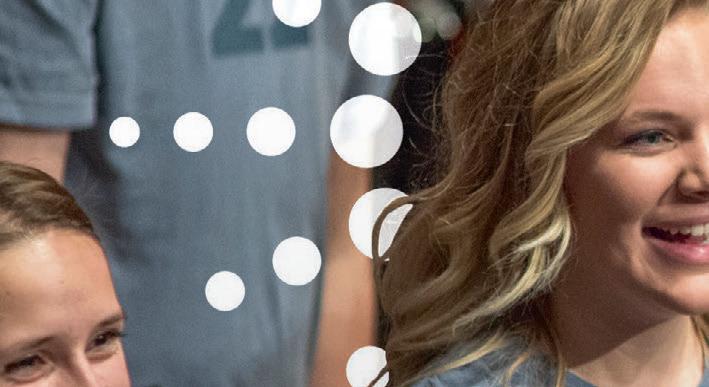
















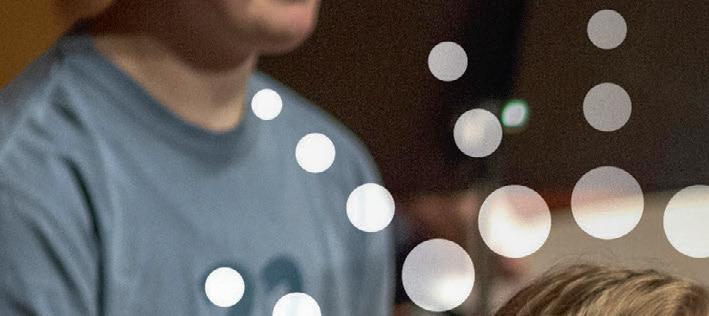






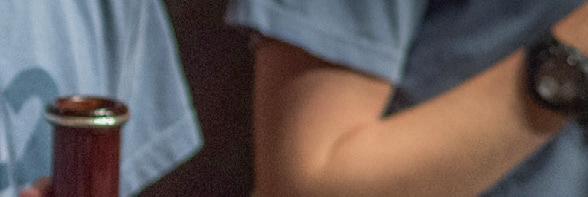












Contemporary Youth Orchestra ROB ER T MULLE R I F YO U’ RE LO OK ING TO create something magical. E P L O R E N L I NE ClevelandArtsEvents .com connects you to the region’s vibrant arts and culture scene With just a few clicks, discover hundreds of events made possible in part with public funding from Cuyahoga Arts & Culture.
Leif Ove Andsnes
piano
“A PIANIST OF magisterial elegance, power, and insight” (The New York Times), Leif Ove Andsnes is “one of the most gifted musicians of his generation” (Wall Street Journal). With his commanding technique and searching interpretations, the celebrated Norwegian pianist has won acclaim worldwide, playing in the world’s leading concert halls and with its foremost orchestras, while building an esteemed and extensive discography. He is the founding director of the Rosendal Chamber Music Festival, was co-artistic director of the Risør Festival of Chamber Music for nearly two decades, and has served as music director of California’s Ojai Music Festival.
This season, Mr. Andsnes performs Dvořák’s piano cycle Poetic Tone Pictures, both on a new Sony Classical release and on recital tours of Europe and North America. In addition to his appearances in Cleveland, he showcases his interpretation of Grieg’s concerto with the Leipzig Gewandhaus, NDR Elbphilharmonie, and London Philharmonic Orchestra; and performs Rachmaninoff’s Third with the Oslo Philharmonic and Royal Scottish National Orchestra. Other highlights include lieder recitals with baritone Matthias Goerne, with whom he recently received his 11th Grammy nomination.
Mr. Andsnes records exclusively for Sony Classical. His previous discography
comprises more than 30 discs for EMI Classics, and he has been awarded many international prizes including six Gramophone Awards.
Mr. Andsnes has received Norway’s distinguished honor, Commander of the Royal Norwegian Order of St. Olav, as well as the prestigious Peer Gynt Prize. He is also the recipient of the Royal Philharmonic Society’s Instrumentalist Award and the Gilmore Artist Award.
Born in Karmøy, Norway, in 1970, Leif Ove Andsnes studied at the Bergen Music Conservatory with Jirí Hlinka. He also received invaluable advice from the Belgian piano teacher Jacques de Tiège, who greatly influenced his style and philosophy of playing. He is currently an artistic adviser for the Prof. Jirí Hlinka Piano Academy in Bergen, where he lives with his family.

THE CLEVELAND ORCHESTRA | 21 clevelandorchestra.com
THE ARTIST
PHOTO BY HELGE HANSEN/SONY MUSIC ENTERTAINMENT
Blossom Summer Soirée
SUNDAY, JULY 23
BLOSSOM MUSIC CENTER
Join us for a magical evening to benefit The Cleveland Orchestra’s summer home. You’ll enjoy a festive dinner party complete with seasonal summer cocktails and friends in Knight Grove. Then you’ll be treated to a concert of American Songbook classics, performed by renowned artists Jean-Yves Thibaudet, Michael Feinstein, and your Cleveland Orchestra. Learn more and reserve your tickets at clevelandorchestra.com/soiree
Proud Presenting Sponsor of the Blossom Summer Soirée

NOW IN ITS SECOND CENTURY , The Cleveland Orchestra, under the leadership of music director Franz WelserMöst since 2002, is one of the most sought-after performing ensembles in the world. Year after year, the ensemble exemplifies extraordinary artistic excellence, creative programming, and community engagement. The New York Times has called Cleveland “the best in America” for its virtuosity, elegance of sound, variety of color, and chamberlike musical cohesion.
Founded by Adella Prentiss Hughes, the Orchestra performed its inaugural concert in December 1918. By the middle of the century, decades of growth and sustained support had turned it into one of the most admired globally.
The past decade has seen an increasing number of young people attending concerts, bringing fresh attention to The Cleveland Orchestra’s legendary sound and committed programming. More recently, the Orchestra launched several bold digital projects, including the streaming broadcast series In Focus, the podcast On a Personal Note, and its own recording label, a new chapter in the Orchestra’s long and distinguished recording and broadcast history. Together, they have captured the Orchestra’s unique artistry and the musical achievements of the Welser-Möst and Cleveland Orchestra partnership.


The 2022/23 season marks Franz
Welser-Möst’s 21st year as music director, a period in which The Cleveland Orchestra earned unprecedented acclaim around the world, including a series of residencies at the Musikverein in Vienna, the first of its kind by an American orchestra, and a number of acclaimed opera presentations.
Since 1918, seven music directors —
Nikolai Sokoloff, Artur Rodziński, Erich Leinsdorf, George Szell, Lorin Maazel, Christoph von Dohnányi, and Franz Welser-Möst — have guided and shaped the ensemble’s growth and sound. Through concerts at home and on tour, broadcasts, and a catalog of acclaimed recordings, The Cleveland Orchestra is heard today by a growing group of fans around the world.
THE CLEVELAND ORCHESTRA | 23 clevelandorchestra.com
THE CLEVELAND ORCHESTRA
@ClevelandOrchestra @clevelandorchestra @CleveOrchestra @Cleveorch
PHOTO BY ROGER MASTROIANNI
THE CLEVELAND ORCHESTRA

Franz Welser-Möst, MUSIC DIRECTOR
Kelvin Smith Family Chair
FIRST VIOLINS
David Radzynski
CONCERTMASTER
Blossom-Lee Chair
Peter Otto
FIRST ASSOCIATE CONCERTMASTER
Virginia M. Lindseth, PhD, Chair
Jung-Min Amy Lee
ASSOCIATE CONCERTMASTER
Gretchen D. and Ward Smith Chair
Jessica Lee
ASSISTANT CONCERTMASTER
Clara G. and George P. Bickford Chair
Stephen Tavani
ASSISTANT CONCERTMASTER
Wei-Fang Gu
Drs. Paul M. and Renate H.
Duchesneau Chair
Kim Gomez
Elizabeth and Leslie
Kondorossy Chair
Chul-In Park
Harriet T. and David L.
Simon Chair
Miho Hashizume
Theodore Rautenberg Chair
Jeanne Preucil Rose
Larry J.B. and Barbara S. Robinson Chair
Alicia Koelz
Oswald and Phyllis Lerner
Gilroy Chair
Yu Yuan
Patty and John Collinson
Chair
Isabel Trautwein
Trevor and Jennie Jones
Chair
Katherine Bormann
Analisé Denise Kukelhan
Gladys B. Goetz Chair
Zhan Shu
SECOND VIOLINS
Stephen Rose*
Alfred M. and Clara T.
Rankin Chair
Eli Matthews1
Patricia M. Kozerefski and Richard J. Bogomolny
Chair
Sonja Braaten Molloy
Carolyn Gadiel Warner
Elayna Duitman
Ioana Missits
Jeffrey Zehngut
Sae Shiragami
Kathleen Collins
Beth Woodside
Emma Shook
Dr. Jeanette Grasselli
Brown and Dr. Glenn R.
Brown Chair
Yun-Ting Lee
Jiah Chung Chapdelaine
VIOLAS
Wesley Collins*
Chaillé H. and Richard B.
Tullis Chair
Lynne Ramsey1
Charles M. and Janet G.
Kimball Chair
Stanley Konopka2
Mark Jackobs
Jean Wall Bennett Chair
Lisa Boyko
Richard and Nancy
Sneed Chair
Richard Waugh
Lembi Veskimets
The Morgan Sisters Chair
Eliesha Nelson
Joanna Patterson Zakany
William Bender
Gareth Zehngut
CELLOS
Mark Kosower*
Louis D. Beaumont Chair
Richard Weiss1
The GAR Foundation Chair
Charles Bernard2
Helen Weil Ross Chair
Bryan Dumm
Muriel and Noah Butkin
Chair
Tanya Ell
Thomas J. and Judith Fay
Gruber Chair
Ralph Curry
Brian Thornton
William P. Blair III Chair
David Alan Harrell
Martha Baldwin
Dane Johansen
Paul Kushious
BASSES
Maximilian Dimoff*
Clarence T. Reinberger
Chair
Derek Zadinsky2
Charles Paul1
Mary E. and F. Joseph Callahan Chair
Mark Atherton
Thomas Sperl
Henry Peyrebrune
Charles Barr Memorial Chair
Charles Carleton
Scott Dixon
HARP
Trina Struble*
Alice Chalifoux Chair
FLUTES
Joshua Smith*
Elizabeth M. and William C. Treuhaft Chair
Saeran St. Christopher
Jessica Sindell2
Austin B. and Ellen W.
Chinn Chair
Mary Kay Fink
PICCOLO
Mary Kay Fink
Anne M. and M. Roger Clapp Chair
OBOES
Frank Rosenwein*
Edith S. Taplin Chair
Corbin Stair
Sharon and Yoash Wiener Chair
Jeffrey Rathbun2
Everett D. and Eugenia S.
McCurdy Chair
Robert Walters
ENGLISH HORN
Robert Walters
Samuel C. and Bernette K. Jaffe Chair
CLARINETS
Afendi Yusuf*
Robert Marcellus Chair
Robert Woolfrey
Victoire G. and Alfred M. Rankin, Jr. Chair
Daniel McKelway2
Robert R. and Vilma L.
Kohn Chair
Amy Zoloto
E-FLAT CLARINET
Daniel McKelway
Stanley L. and Eloise M. Morgan Chair
BASS CLARINET
Amy Zoloto
Myrna and James Spira Chair
BASSOONS
John Clouser*
Louise Harkness Ingalls Chair
Gareth Thomas
Barrick Stees2
Sandra L. Haslinger Chair
Jonathan Sherwin
CONTRABASSOON
Jonathan Sherwin
HORNS
Nathaniel Silberschlag*
George Szell Memorial Chair
24 | 2022/2023 SEASON
Michael Mayhew§ Knight Foundation Chair
Jesse McCormick
Robert B. Benyo Chair
Hans Clebsch
Richard King
TRUMPETS
Michael Sachs* Robert and Eunice Podis
Weiskopf Chair
Jack Sutte
Lyle Steelman2
James P. and Dolores D. Storer Chair
Michael Miller
CORNETS
Michael Sachs*
Mary Elizabeth and G. Robert Klein Chair
Michael Miller
TROMBONES
Brian Wendel*
Gilbert W. and Louise I. Humphrey Chair
Richard Stout Alexander and Marianna C. McAfee Chair
Shachar Israel2
EUPHONIUM & BASS TRUMPET
Richard Stout
TUBA
Yasuhito Sugiyama*
Nathalie C. Spence and Nathalie S. Boswell Chair
TIMPANI
Paul Yancich*
Otto G. and Corinne T. Voss Chair
PERCUSSION
Marc Damoulakis*
Margaret Allen Ireland Chair
Donald Miller
Thomas Sherwood
KEYBOARD INSTRUMENTS
Carolyn Gadiel Warner
Marjory and Marc L. Swartzbaugh Chair
LIBRARIANS
Michael Ferraguto
Joe and Marlene Toot Chair
Donald Miller
ENDOWED CHAIRS
CURRENTLY UNOCCUPIED
Elizabeth Ring and William
Gwinn Mather Chair
Paul and Lucille Jones Chair
James and Donna Reid Chair
Sunshine Chair
Mr. and Mrs. Richard K.
Smucker Chair
Rudolf Serkin Chair
CONDUCTORS
Christoph von Dohnányi MUSIC DIRECTOR
LAUREATE
Daniel Reith
ASSISTANT CONDUCTOR
Sidney and Doris Dworkin Chair
Lisa Wong
DIRECTOR OF CHORUSES
Frances P. and Chester C. Bolton Chair
* Principal
§ Associate Principal
1 First Assistant Principal
2 Assistant Principal
This roster lists full-time members of The Cleveland Orchestra. The number and seating of musicians onstage varies depending on the piece being performed. Seating within the string sections rotates on a periodic basis.
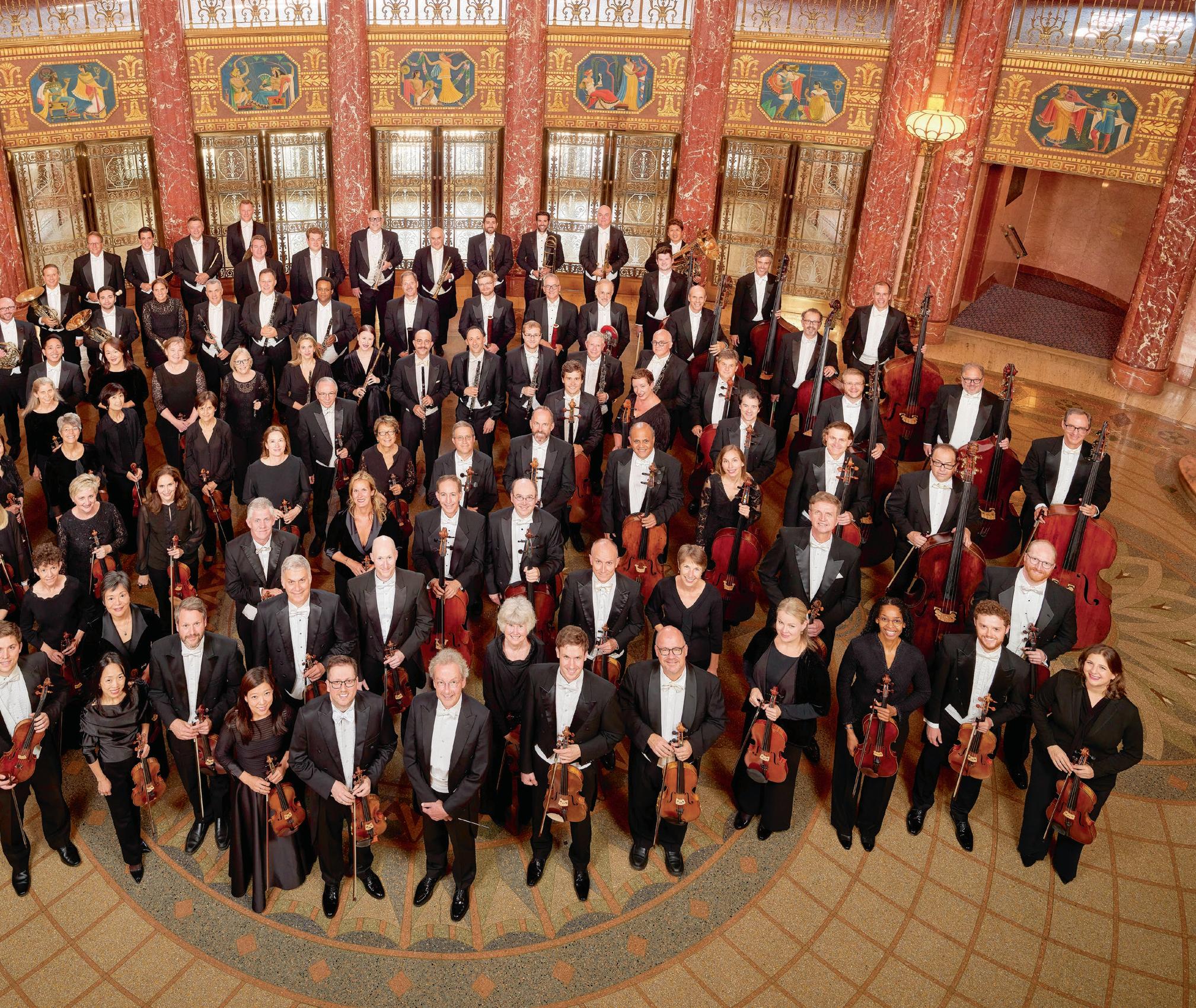
THE CLEVELAND ORCHESTRA | 25 clevelandorchestra.com
PHOTO BY ROGER MASTROIANNI
APR 13, 15, 16
MAHLER’S TITAN
Michael Tilson Thomas, conductor
Leif Ove Andsnes, piano
DEBUSSY Jeux; poème dansé
DEBUSSY Fantaisie for Piano and Orchestra
MAHLER Symphony No. 1 (“Titan”)
APR 20, 21, 22, 23
ALL MOZART
Bernard Labadie, conductor Lucy Crowe, soprano
MOZART Overture to La clemenza di Tito
MOZART “Giunse al fin il momento... Al desio di chi t’adora”
MOZART Ruhe Zanft from Zaide
MOZART Masonic Funeral Music
MOZART “Venga la morte... Non temer, amato bene”
MOZART Symphony No. 41 (“Jupiter”)
APR 27, 28, 29
MARSALIS AND NEW
WORLD
Franz Welser-Möst, conductor
Michael Sachs, trumpet
EASTMAN Symphony No. 2
MARSALIS Concerto for Trumpet DVOŘÁK Symphony No. 9 (“From the New World”)
MAY 3
MARIA JOÃO PIRES IN RECITAL
Maria João Pires, piano
SCHUBERT Piano Sonata No. 13
DEBUSSY Suite Bergamasque
SCHUBERT Piano Sonata No. 21
MAY 4, 6
WEILERSTEIN PLAYS BARBER
Franz Welser-Möst, conductor
Alisa Weilerstein, cello
LOGGINS-HULL Can You See?
BARBER Cello Concerto
PROKOFIEV Symphony No. 4
MAY 14, 17, 20
THE GIRL OF THE GOLDEN WEST
Franz Welser-Möst, conductor
Tamara Wilson, soprano (Minnie)
Roman Burdenko, bass (Jack Rance)
Limmie Pulliam, tenor (Dick Johnson)
Cleveland Orchestra Chorus
PUCCINI La Fanciulla del West (The Girl of the Golden West)
The Opera presentation is sung in Italian with projected supertitles.
The place for fans of The Cleveland Orchestra!
TCO REWARDS
IT’S FREE
TCO Rewards are a FREE feature of your Cleveland Orchestra account. Simply login, or create an account and click Rewards.

IT’S EASY
Earn points for all the things you already do with The Cleveland Orchestra, such as attend concerts, watch videos, and read articles.
GREAT PERKS
Use your points to get great perks like tickets, merchandise, VIP experiences, and exclusive content.
It’s easy to get TCO Rewards points and earn your way toward great perks like seat upgrades, merchandise, exclusive content, and more!
SPECIAL OFFER
Join us this spring! clevelandorchestra.com
Enter 2223PROGRAM and earn 10 bonus points clevelandorchestra.com/rewards
A FESTIVAL OF CONCERTS, CONVERSATIONS & IDEAS
FESTIVAL CONCERTS & KEYNOTE
MAY 11
FRAGMENTS 1
Alisa Weilerstein,
MAY 13
KEYNOTE SPEAKER ISABEL WILKERSON
MAY 14, 17 & 20
PUCCINI’S OPERA IN CONCERT
THE GIRL OF THE GOLDEN WEST

The Cleveland Orchestra
Franz Welser-Möst, conductor
Tamara Wilson, soprano (Minnie)
Roman Burdenko, bass (Jack Rance)
Limmie Pulliam, tenor (Dick Johnson)
Cleveland Orchestra Chorus
MAY 19
DREAMS WE’VE DREAMED; SONGS WE’VE SUNG; HOPES WE’VE HELD
The Cleveland Orchestra
















































Franz Welser-Möst, conductor
FREE EVENTS
MAY 13
UNITED IN SONG!
A COMMUNITY CELEBRATION
MAY 18
THE AMERICAN DREAM, THE AMERICAN NIGHTMARE, AND BLACK AMERICAN MUSIC
MAY 20
EXPLORATIONS OF THE AMERICAN DREAM
MAY 11–20
SEVERANCE MUSIC CENTER
Scan the QR code for more festival information & details.

HEALTH & SAFETY
The Cleveland Orchestra is committed to creating a comfortable, enjoyable, and safe environment for all guests at Severance Music Center. While mask and COVID-19 vaccination are recommended they are not required. Protocols are reviewed regularly with the assistance of our Cleveland Clinic partners; for up-to-date information, visit: clevelandorchestra. com/attend/health-safety
LATE SEATING
As a courtesy to the audience members and musicians in the hall, late-arriving patrons are asked to wait quietly until the first convenient break in the program. These seating breaks are at the discretion of the House Manager in consultation with the performing artists.
PAGERS, CELL PHONES & WRISTWATCH ALARMS
As a courtesy to others, please silence all devices prior to the start of the concert.
PHOTOGRAPHY, VIDEOGRAPHY & RECORDING
Audio recording, photography, and videography are prohibited during performances at Severance. Photographs can only be taken when the performance is not in progress.
HEARING AIDS & OTHER HEALTH-ASSISTIVE DEVICES
For the comfort of those around you, please reduce the volume on hearing aids and other devices that may produce a noise that would detract from the program. For Infrared Assistive-Listening Devices, please see the House Manager or Head Usher for more details.
FREE MOBILE APP TICKET WALLET
IN THE EVENT OF AN EMERGENCY
Contact an usher or a member of house staff if you require medical assistance. Emergency exits are clearly marked throughout the building. Ushers and house staff will provide instructions in the event of an emergency.
AGE RESTRICTIONS
Regardless of age, each person must have a ticket and be able to sit quietly in a seat throughout the performance. Classical season subscription concerts are not recommended for children under the age of 8. However, there are several age-appropriate series designed specifically for children and youth, including Music Explorers (for 3 to 6 years old) and Family Concerts (for ages 7 and older).
The Cleveland Orchestra is grateful to the following organizations for their ongoing generous support of The Cleveland Orchestra: the State of Ohio and Ohio Arts Council and to the residents of Cuyahoga County through Cuyahoga Arts and Culture.
For more information and direct links to download, visit clevelandorchestra.com/ticketwallet or scan the code with your smartphone camera to download the app for iPhone or Android.
Available for iOS and Android on Google Play and at the Apple App Store.
The Cleveland Orchestra is proud of its long-term partnership with Kent State University, made possible in part through generous funding from the State of Ohio. The Cleveland Orchestra is proud to have its home, Severance Music Center, located on the campus of Case Western Reserve University, with whom it has a long history of collaboration and partnership.
© 2023 The Cleveland Orchestra and the Musical Arts Association
Program books for Cleveland Orchestra concerts are produced by The Cleveland Orchestra and are distributed free to attending audience members.
EDITORIAL
Amanda Angel, Program Editor, Managing Editor of Content aangel@clevelandorchestra.com
Kevin McBrien, Editorial Assistant
DESIGN
Elizabeth Eddins, eddinsdesign.com
ADVERTISING
Live Publishing Company, 216-721-1800
28 | 2022/2023 SEASON
YOUR VISIT
Download today for instant, secure and paperless access to your concert tickets.
clevelandorchestra.com Cleveland Orchestra performances are broadcast as part of regular programming on ideastream/WCLV Classical 90.3 FM, Saturdays at 8 p.m. and Sundays at 4 p.m.

Open now | Tickets at cma.org | CMA Members FREE
Henry VIII, “Bloody Mary,” and Elizabeth “The Virgin Queen” as you immerse yourself in the opulence and drama of the Tudor reign. Featuring iconic portraits, intricately wrought armor, glittering tapestries woven with gold and more, this fascinating exhibition explores the magnificent art that fostered a dynasty.
Kind.
AND M AJESTY IN RENAISSANCE ENGLAND
E
U D O R S
Meet
Guess I’m Just The Marrying
ART
TH
T
RENAISSANCE ENGLAND TH E
O R S
ART AND M AJESTY IN
TUD
RENAISSANCE ENGLAND
O R S Henry VIII (detail), c. 1537. Workshop of Hans Holbein the Younger. Oil on panel; 239 x 134.5 cm. National Museums Liverpool, Walker Art Gallery, Purchased by the Walker Art Gallery in 1945, WAG 1350 cma.org
ART AND M AJESTY IN
TH E TUD
A SYMPHONY OFSuccess

We believe that all Cleveland youth should have access to high-quality arts education. Through the generosity of our donors, we are investing to scale up neighborhoodbased programs that now serve 3,000 youth year-round in music, dance, theater, photography, literary arts and curatorial mastery. That’s a symphony of success. Find your passion, and partner with the Cleveland Foundation to make your greatest charitable impact.

(877)554-5054
w ww.ClevelandFoundation.org
Institute El Sistema Orchestra
Rainey











 — Peter Laki
— Peter Laki

 Macdonald
Macdonald





















































































